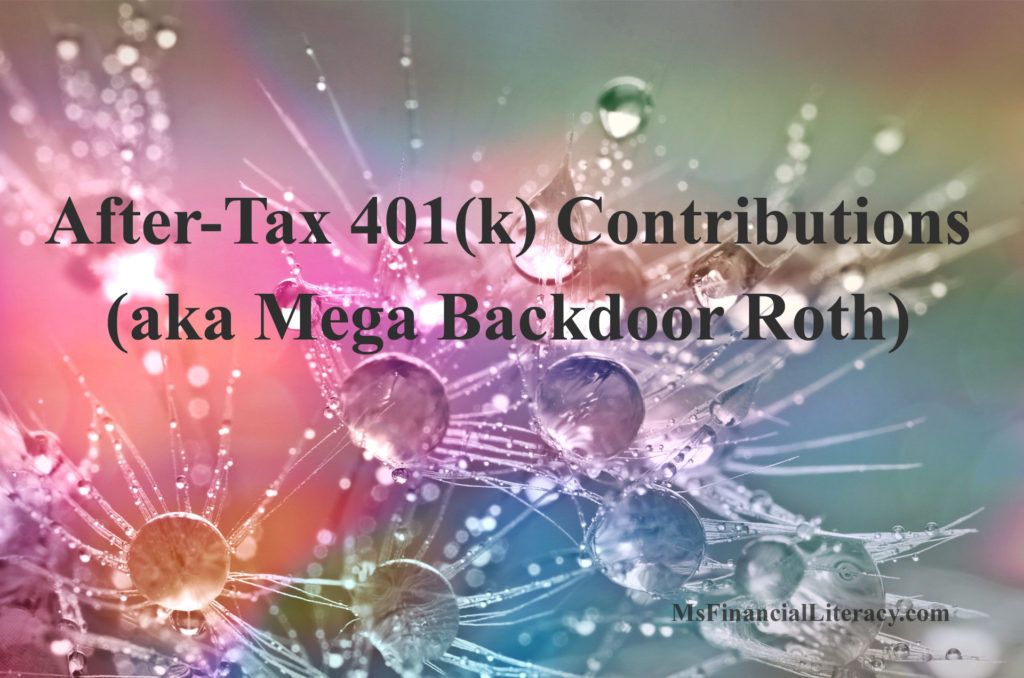If you live in the U.S. and work for a decent size employer, you’ve probably heard of a pretax 401(k) profit-sharing plan. You can read my previous articles on 401(k) by following this link here. In this article, I walk you through what are after-tax 401(k) contributions and how this is different from a traditional (pre-tax) 401(k) plan or Roth 401(k). I cover how this plan works and why might you want to make after-tax contributions to a 401(k), provided it’s available to you through your employer. I also share the insights my husband and I have learned regarding after-tax contributions, such as rollover options.

I first read about after-tax contributions just about a year ago. I recall sharing that information with my husband afterward and we wished such an option was available to either one or both of us through our employers. To our surprise, our wish came true a few months later. My husband’s employer made the after-tax 401(k) contribution option available. Since then, both of us have learned a lot more about the rules that govern the after-tax 401(k).
What is an After-Tax 401(k) Contribution?
Sometimes, the after-tax 401(k) is also referred to as the mega backdoor Roth. This plan allows qualifying participants to set aside more money toward their retirement accounts, using after-tax money (that is, money they get paid that they’ve already paid tax on).
Currently, the maximum amount plan participants are allowed to contribute to a pre-tax 401(k) is $18,000. Just like like a traditional (pre-tax) 401(k), there are no income limits/restrictions. If your employer allows after-tax contributions to your 401(k), you may be allowed to save up to the $54,000 IRS limit for 2017. This amount is an overall cap, which includes your $18,000 pre-tax contributions plus any employer contributions.
Let’s say for year 2017, you plan to max your pre-tax 401(k) contribution plus 3% match on $100,000 salary. This combined number equals to $21,000. Subtracting this amount from $54,000 gives you $33,000 max to put toward your after-tax 401(k).
However, keep in mind that some employers who offer the after-tax contributions might not allow their employees to contribute up to the IRS limit for the year. For instance, your employer might set such a rule that you’re only allowed to contribute 10% of your income per pay period toward your after-tax contribution plan. Check with your HR and plan administer to learn what’s available to you.
After-Tax 401(k) Plan is Not the Same as a Roth 401(k)
It’s important to note that an after-tax 401(k) plan is not the same as a Roth 401(k). While both plans take after-tax money as contributions, the rules governing the two plans vary (e.g., when doing a rollover and when taxes are being paid). My previous employer provided me the option to contribute to either a pre-tax 401(k) plan or a Roth 401(k). I put 100% of my 401(k) contributions to the pre-tax plan.
Saving $18,000 of after-tax savings is more difficult than saving $18,000 of pre-tax savings. The U.S. government subsidizes your funding of a pre-tax 401(k) by lowering your taxable income(s). Our personal opinion is that, for most qualifying employees, the Roth 401(k) is a poorer and inferior option to the traditional pre-tax 401(k).
So why might some people choose to fund a Roth 401(k) instead of pre-tax 401(k)? The thinking is that their marginal (i.e. highest) tax rate will be higher later in life when they are withdrawing from their retirement accounts than it is right now. If that really is the case, then, selecting the Roth 401(k) might be the correct option. However, you also have to consider the investment growth (gains), dividends, and interest you can make on any money you save by not paying taxes up front (right now).
The reality for most people is that their incomes are lower during retirement years than during their working years. Also, any income pulled from Roth IRA accounts is not taxed anyway. Social security income also has different, and slightly more favorable, taxation rules. Retirees also have choices as to how much income to take, when to take it, and from which accounts to pull from. All of these factors make the Roth 401(k) an even less appealing choice.
No one knows better about your specific financial situation than you do. As I like to encourage others to do both in real life and on the blog here, learn the financial language, find out what’s financially possible for you and do some financial planning :).
Why Might You Want to Contribute to an After-Tax 401(k)?
At first, I thought this was just like a taxable account, where you purchase stocks with after-tax money. However, my husband pointed out that there’s a delayed tax advantage contributing to a after-tax 401(k). And this is the attractive part.
When you go sell stocks in your taxable account, you’d have to pay taxes on the gains at the tax bracket(s) you’re currently at for the year. If your income is low, then putting money in a taxable account might be the way to go. You wouldn’t have to wait until age 59 ½ or older to access the money (with some exceptions). Most people who take advantage of the after-tax 401(k) plan are those who are on the higher side of tax brackets and looking for ways to shield their hard earned money from taxes.
Plan participants still have to pay taxes on the gains in the after-tax 401(k) at time of rollover (yes, you can rollover this plan to other retirement accounts, which I discuss in the next section below). However, there are ways to minimize the amount of taxes you pay or possibly totally avoid it by using certain legal strategies (I also talk about this in the next section below).
Rollover Options
Just like his pretax 401(k) plan, the after-tax contributions are also administered through a third party administrator. On my husband’s account, the balance on his pre-tax 401(k) is separate from the balance on his after-tax.
At this point, neither my husband nor I know if all participating employers offer plan participants the option to rollover while they’re still employed. Speak with your HR and plan administer to find out what’s possible for you.
From what we’ve learned thus far, some employers allow employees to do a rollover up to four times a year, while others allow unlimited rollovers (this is the case for my husband).
Words of caution: When provided with unlimited rollovers, you might be tempted to do a rollover each time you get paid or once every month. Who wouldn’t want to keep more of their gains (and you can do that when the investments are in your Roth IRA)? However, your plan administer might charge you a fee to do a rollover each time. My husband pays $20 for each rollover. And he plans to do a rollover every two months.
Typically, you’d rollover the contributions into a Roth IRA (both your own contributions and gains). I speculate this is where the name, mega backdoor Roth, is derived from. And you’d have to pay taxes only on your gains at the time of rollover. Once again, how much taxes you pay depends on your income tax bracket(s). Another option your plan administer might offer is to rollover the contributions portion into a Roth IRA and the gains into a traditional IRA. This way, plan participants won’t have to pay taxes on the gains at the time of rollover. However, the tax rules for a traditional IRA still applies—you pay taxes at the time you withdraw money from that account.
When it came time to do the rollover, my husband chose the latter option; he rolled over the contributions into his Roth IRA and the gains into his traditional IRA. And he did this with a tax strategy in mind. During years when our incomes are low, we plan to construct a Roth IRA conversion ladder and avoid paying any taxes on the gains (I will write a post on this topic soon. Look out for it.).
After the rollover, you’ll never pay taxes again on the gains or the dividends! Furthermore, the money becomes accessible 5 years after the rollover if you need it for any reason. Be wary, though, once taken out you can never put it back into the Roth IRA account.
Some Final Remarks
At the time of this writing, the number of employers offering the after-tax 401(k) plan is relatively small. Furthermore, very few of those qualifying employees actually take advantage of this option.
Think about this: if you’re one of those who are contributing to an after-tax 401(k), this implies that you’re already saving $18,000 per year toward retirement in pre-tax contributions via a traditional 401(k). For this very reason, few employees have both the capability and the desire to save more than $18,000 toward their retirement. If you’re in this category, you are being highly rewarded for all the tax reasons already mentioned above—at first, you defer paying taxes on your investment gains and eventually pay no taxes on the additional gains or dividends once those contributions get rolled-over.
Based on what we’ve learned and understand of after-tax 401(k) plans, they are extremely appealing! If such option is available to you and/or your spouse, then congratulations. I hope you’re already taking advantage of them and seeing their rewards. If not, then see if you can devise a budgeting plan to help you get there (see my article on budgeting by visiting this link).
This article contains many financial terms. They are similar in some ways, yet very different in other ways. Even the names themselves are confusing (pre-tax 401(k)? after-tax 401(k)? Roth 401(k)? Roth IRA? Traditional IRA?). If this is the first time you’ve read about some of them, I feel you. I’m still learning about the different rules that govern each and what I can do with each. The various rollover options also introduced more learning. I invite you to ask me questions on the comments section below. If I don’t already know the answer, I’d love to learn together with you.
Like what you’ve just read? I encourage you to sign up for my free weekly newsletter that goes out every Monday to receive updates on new posts.
